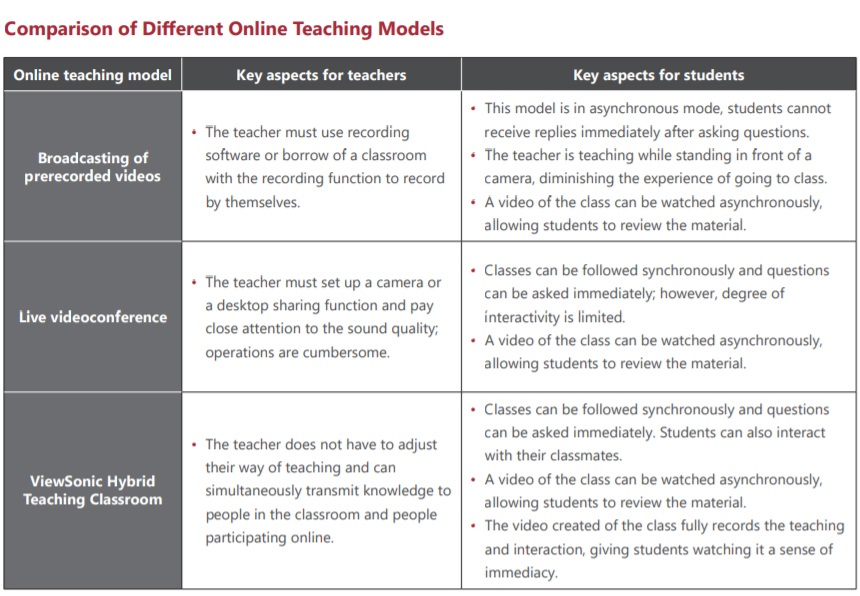12/06/2021
Beyond Interactive Whiteboards – Developing Technology to Meet the Needs of Post-Pandemic Learning
Once upon a time schools and colleges had interactive whiteboards but many teachers found these unsatisfactory. The glare, the audio quality, problems with Lighting and Display. In fact, often they were just used to display static PowerPoint type activities. They were interactive in the sense that the teachers could make things happen on screen but students were only involved if they got out of their seat, came to the front and touched the board. This was often slow and disruptive. In early years some pupils were just too short to use the board and then came Covid and many schools realised that students with Remote Access were at a disadvantage when it came to participation.
The pandemic continues and schools and universities have realised that hybrid teaching is here to stay. They must integrate online and physical classrooms, as well as synchronous and asynchronous teaching. To do this, they need new models of teaching and new technology if they are to increase interactivity and transcend the time and space limitations of the traditional classroom.
These were some of the issues facing Chung Yuan Christian University in Taoyuan City, Taiwan. The Department of Teaching Chinese as a Second Language had 16,217 students enrolled in the academic year 2019-2020.The university worked with ViewSonic, a leader in audio visual for over 30 years to create and test out a hybrid teaching classroom that would take into account the overall teaching environment, the needs of teachers, as well as the requirements of individual courses.
Challenge
In recent years, the internet and technology have developed rapidly ,boosting global demand for digital forms of learning, such as mobile and online learning. Chung Yuan Christian University has promoted online teaching for several years by using pre-recorded videos so students can learn asynchronously and remotely, and developing massive open online courses(MOOCs), which enabled the university to be at the forefront of technology based education.
However, teachers were still encountering many difficulties in online teaching.
- Teachers need to produce asynchronous distance courses in advance using recording software or borrowing recording classrooms;
- On the other hand, synchronous distance teaching models—using, for example, videoconferencing—involves cameras and desktop sharing functions.
- Poor audio and video quality is frustrating for teachers and students alike, while operational procedures can be quite cumbersome. In addition, dividing students into different groups for synchronous and asynchronous learning requires even more preparation work.
Following the outbreak of COVID-19 in early 2020, there was tremendous demand for online learning. However, in remote teaching, the face-to-face, real-time interaction amongst teachers and students is much less than that of physical courses. Due to the pandemic, students were unable to return to school and could not muster their interest when watching pre-recorded videos because there was no interaction. This led to teachers spending a great deal of time adapting to and preparing for online lectures.
It is unclear whether the pandemic will end or become even more of a problem so hybrid education is likely to become mainstream and institutions need to safeguard the quality of teaching and learning.
Solution
Having considered the various challenges faced by the university and its teachers and students, ViewSonic created a hybrid teaching classroom for the 'Department of Teaching Chinese as a Second Language', which meets the demands of all types of education.
The core purpose of the ViewSonic hybrid teaching classroom is to give equal weight to classroom and online teaching. It fully integrates online teaching into the classroom and enables teachers to interact with remote students in the same way as with students who are in the classroom. The hybrid teaching classroom uses the ViewBoard interactive display, the myViewBoard digital whiteboarding solution, projectors and other hardware equipment, and software solutions.
Teachers can simultaneously see students in the classroom and students participating remotely and can synchronously conduct livestreams with the ability to talk directly to students watching the livestream.
Furthermore, through a screen projected at the back of the classroom, the teacher can view the status of the class and does not have to constantly look back towards the whiteboard. The teacher can thus focus more on the course or activity and maintain a high level of interactivity with the students.
Key Aspects of the ViewSonic Hybrid Teaching Classroom
• ViewBoard interactive display: The 86"interactive display installed at the front of the classroom is equipped with the myViewBoard digital whiteboarding solution, enabling teachers to conduct varied interactive teaching. For example, they can make notes on, edit, or create content on the display or image-based materials in real time. They can also create different types of tests, such as multiple answer tests or quizzes.
• myViewBoard digital whiteboarding solution: This platform provides an open environment capable of supporting different systems. Students can take part in remote learning without any restrictions associated with their location. In a virtualized classroom, teachers and students can take advantage of easy-to-use video connections for discussions and collaboration. With the help of a wide range of tools, the platform delivers a fun, interactive, and efficient virtual learning experience.
• Pen display: This technology lets teachers maintain a handwriting habit and write things on a professional 13.3" screen. This will be projected instantly on the ViewBoard.
• Two projectors: One projector displays a real time view of the teacher doing his or her work at the front of the room, while the other projector shows students participating in the class virtually. The projectors can also simultaneously show teaching slides and the situation in the classroom. This generates even greater teaching flexibility in a multiscreen teaching environment.
• Two cameras: One camera is in the middle of the classroom and records the teacher; its panning camera follows the teacher's movements and automatically selects the best lens. The other camera, installed at the front of the classroom, records the students in the room, giving students who are participating virtually a sense of being in the classroom with the teacher and their fellow students.
• Wireless microphone: The microphone directly records the teacher's voice and transmits it synchronously to the sound system in the classroom, the online teaching system, and the livestream

To ensure the pandemic does not affect student learning, the ViewSonic hybrid teaching classroom simulates traditional teaching situations and covers the real classroom, remote teaching, livestream teaching, and recorded teaching. It also enables teachers to implement remote teaching without any extra effort and accelerates the spread of hybrid teaching models around the world.
Advantages for students
Learning does not stop. Since ViewSonic created the hybrid teaching classroom for Chung Yuan Christian University's 'Department of Teaching Chinese as a Second Language', overseas students who have been unable to return to Taiwan because of the pandemic, can still continue to interact with teachers as if they are in the same classroom. If they are unable to attend the class, students can watch the recorded video of the class at a later date to keep up with their studies.
Advantages for teachers
Teachers can meet online synchronous and asynchronous teaching demand by giving a class just once. Furthermore, the environment and interactive nature of the classroom can all be transported online so that teachers do not have to alter their teaching habits and can focus on what they are trained for, which is teaching. The hybrid teaching classroom embeds online teaching equipment into the classroom, eliminating the need for complex setups seen in classrooms built exclusively for online teaching.
This also respects the teaching philosophy of teachers and addresses the reservations they may have about using technological tools. The easy-to-use and intuitive operating interface of the myViewBoard software offers teachers the ability to easily create even more content and easily find additional relevant content online, enlivening teaching and creating even more space for meaningful interaction with students.
Advantages for universities
There are no limits to the number of students in 'class'. Science students can easily connect to the hybrid teaching classroom remotely and can also interact with other participants through the livestream.
Schools are no longer bound by the physical limitations of the classroom, which can normally only accommodate several dozens of students. For instance, during a regular class, Lien Yu-jen, Account Manager at Chung Yuan Christian University's Mandarin Learning Center, teaches 60 students who are in the classroom or take part through a synchronous teaching platform, as well another 100 students and teachers who participate through an online, interactive livestream. The session is then watched another 1,000 times or so asynchronously that is, after the actual class has ended.
Hybrid teaching not only increases the number of students that can be taught in a single class or course, but also eliminates all barriers toward the dissemination of knowledge
Future plans
Technology can help move existing teaching strategies far beyond their traditional scope. Indeed, the hybrid teaching classroom developed by ViewSonic for Chung Yuan Christian University marks a new milestone in the application of technology in the field of education.
Looking ahead, ViewSonic will use this highly successful experience to establish collaboration with even more partners in the global technology education industry chain, further promoting the hybrid classroom and developing even more innovative teaching models with the help of technology.
The goal is to let schools in all corners of the globe enjoy the benefits of technology based education. if schools or private educational institutions in remote areas can make use of hybrid classrooms it will allow students in such areas to receive the same level of education as students in urban areas.
